Are you thinking about planning a cycling adventure but unsure where to start? We have some good news for you. Our friends at Saddle Skedaddle have been planning cycling holidays around the world for almost 30 years. In this blog you can find their top tips to consider when crafting an amazing experience on wheels.
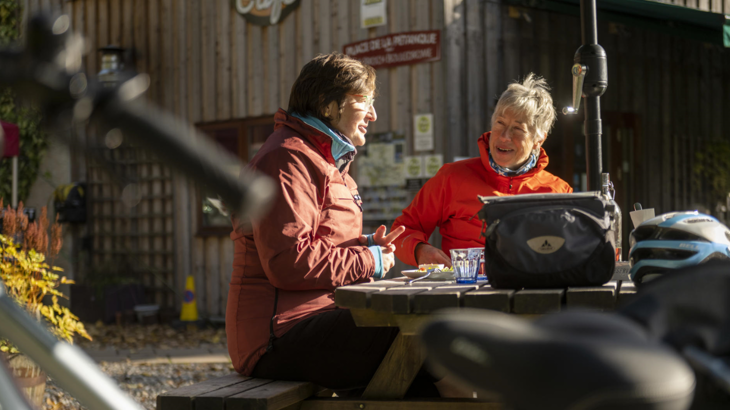
Stopping for a well-earned break. Credit: Sustrans
What’s your ideal destination?
Do you want to see what’s on your doorstep or are you heading further afield to explore?
One of the things we’re passionate about is encouraging people to cycle somewhere they may not have considered before, whether that’s a quiet corner of Northumberland’s National Park or the southern coastline of Sardinia.
We think there’s no better way to experience a place, its people and its culture.
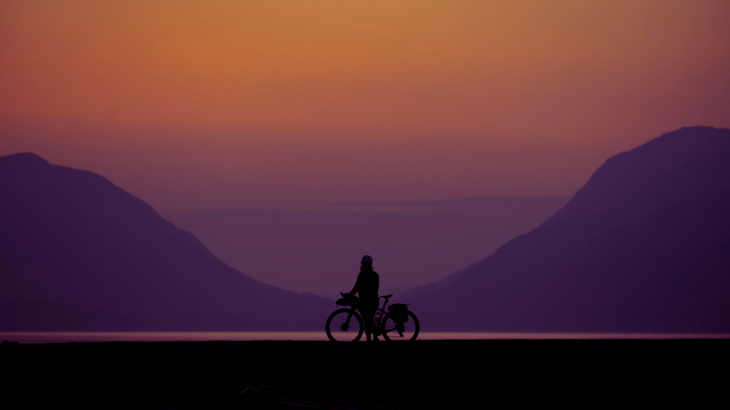
Enjoy some incredible views on your cycling holiday. Credit: Sustrans
Is there an existing route you can ride?
In the UK, we have our incredible National Cycle Network. This can be a great starting point for route planning.
Sustrans promotes a brilliant selection of long-distance and traffic-free cycle routes.
If you’re looking for an off-road adventure, there are some excellent established routes here in the UK, such as the Pennine Bridleway or the Sandstone Way.
If you’re considering a European trip, you’ll also find an extensive network of cycling routes at EuroVelo, including well known routes like the Danube Cycle Path.
Your holiday doesn’t have to follow a single long-distance route. You could plan a series of day rides.
Some guidebooks will even suggest linking routes but beware - if you are using books and websites for lesser-known routes, keep in mind when these were written and anticipate changes such as path diversions or trail conditions.
Off-road routes in particular can be hugely affected by weather. This is one of the reasons we always recce routes before running tours.
If you’re planning your own itinerary, you can check local online communities.
Sustrans' National Cycle Network Facebook group is a great shared resource for feedback on trails and cycle paths on the Network.
Your route planning should also factor in any transport logistics.
If you ride between two locations, can you catch a train back to your start point? Would it be better to cycle a circular route?
A to B journeys are exciting to ride and there’s a real sense of adventure and satisfaction travelling from point A to point B under your own steam. They are also the most logistically complex to plan; something we know very well as we have around 80 of our own itineraries that take you on an A to B journey.

Cycling adventures on the National Cycle Network. Credit: Sustrans
Finding your own route
We know from three decades of experience how fun and challenging this can be.
Thankfully maps and resources have come a long way in 30 years and now there are lots of online resources to tap into.
These are our top tips to keep in mind when planning your own route:
- Consider traffic - be mindful about selecting quieter roads where possible.
- Use Google Street View to scope out roads on your route.
- Keep in mind that bridleways could be well surfaced or they could be overgrown, boggy and barely rideable.
- Use heatmaps (for example with RideWithGPS or Strava) to see how often a particular path or trail is used by other riders. If it’s rarely ridden it might not be the best route.
- Check photos and descriptions online. Komoot, for example, allows lots of detail to be shared.
- Consider the prevailing winds - this could have a big impact on the enjoyment of your trip.
- Be prepared for it all to change on the day. No matter how much research you do, things could change along the way. For some people this adds to the sense of adventure. If you prefer to relax and enjoy the ride, safe in the knowledge that you’ll reach your next overnight stop in good time, we offer more than a hundred unique itineraries you can explore.
Check your challenge level
It’s fun to set yourself a bit of a challenge but you want to make sure that challenge is achievable.
Don’t be tempted to pack too much in. Make sure you leave some wiggle room in the timings for repairs, diversions or simply to stop and enjoy places along the way without feeling rushed.
Distance is an important factor, but pay close attention to route profiles i.e. gradient and ascent. You’ll likely find you can ride further on a cycling holiday because it’s the focus of your day (when you’re not enjoying a nice coffee break or ice cream). However, it’s a good idea to check that the gradients on your chosen route match those of your recent rides.
Keep in mind that you’ll be riding on consecutive days too so you may feel more tired than you would coming in fresh to your weekend pedal. Terrain is another important element, particularly if your route ventures off-road.
Even if your chosen route isn’t packed with technical riding, the surface types will impact how much ground you can cover. Note if you may have to carry your bike at any point too.
How will you navigate?
Even if your chosen route is waymarked, it’s a good idea to have maps handy for route finding. Some of you might prefer paper maps.
You might also consider a GPX unit or app on your phone for convenience. Apps like RideWithGPS, which we use at Skedaddle, offer turn by turn navigation.
We suggest that you carry a paper map as well just in case you experience tech issues.
If you opt to join a guided tour, then you will have an experienced guide to show you the way.
Guides bring a lot more than just navigation – they love to share their local knowledge and stories, keep everyone motivated through the tough climbs and much more. They’ll also be there to help if needed.
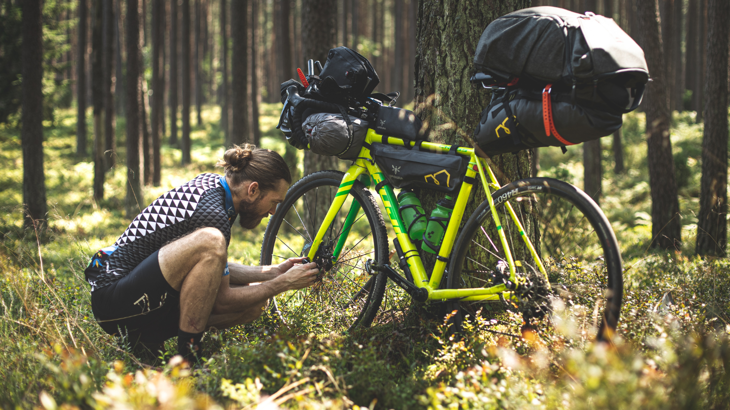
If you’re heading off the beaten track to somewhere very remote, then you’ll want to take more spares and tools with you and enhance your skills for more complex repairs. Credit: Marek Piwnicki at Pexels
Get to you know your bike basics
You’ll need to carry essential bike tools and spare tubes etc so you can fix a problem or puncture along the way.
If something happens that you can’t fix, then how far is it to the nearest bike store? Is there someone you can call?
We provide 24-hour emergency support on all of our tours but if you’re doing a DIY tour then it’s even more important to brush up on your bike servicing skills.
If you’re heading off the beaten track to somewhere very remote, then you’ll want to take more spares and tools with you and enhance your skills for more complex repairs.
For example, if you’re mountain biking through the remote Scottish Highlands, you’ll need to carry extras like quicklinks for your chain, multi-tool with chain tool, a derailleur hanger, tyre repair kit and cable ties, as well as a headtorch and first aid kit, just in case.
Will you be riding an e-bike?
If you’ve got an e-bike then you’ll need to think about charging along the way.
Check with your chosen accommodation that they will allow you to charge the battery. If your battery is integrated, check there is a socket you can use near to where the bike is stored.
We have found that an increasing number of hotels and B&Bs won’t permit charging, even when using reputable e-bike brands.
It’s one of the reasons we’ve invested in our own mobile charging station.
You may also be able to top up your battery at bike-friendly cafes along the way.
If you’ve got a lot of mileage to cover in a day, then remember to ride conservatively to make your battery last the distance.
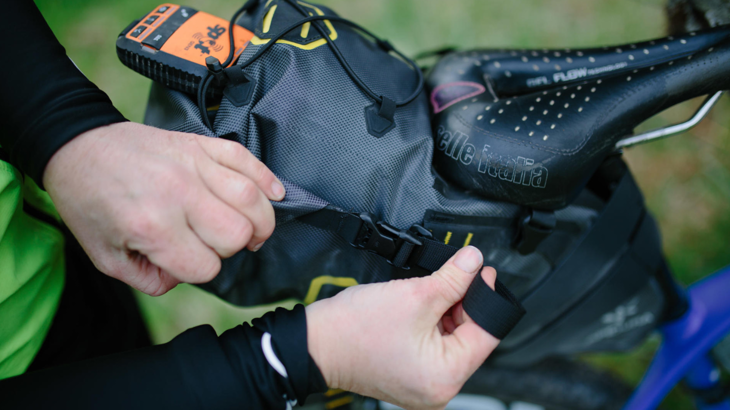
You’ll need to carry essential bike tools and spare tubes etc so you can fix a problem or puncture along the way. Credit: Sustrans
Where will you stay and how long will your trip take?
Many places advertise if they are bike-friendly. You need to know if there is somewhere safe to store your cycle but we’d also recommend using a good lock to secure it overnight.
If you’re camping, then consider the added weight of carrying your equipment. You can lock two bikes together if you’re leaving them outside your tent.
Going back to our earlier tips on setting the right challenge level, you’ll need to match your daily mileage and ascent with your overnight stops.
Make sure that your chosen accommodation or campsite isn’t too far from the end of your day’s riding.
Even a few miles extra can feel like a lot after a long day in the saddle. Plus, you’ll have to ride out again in the morning.
If your overnight stop is in a remote area, then make sure the hotel or B&B offers an evening meal or book ahead with a local pub.
No one wants to miss a much-needed evening meal after a long day of riding.
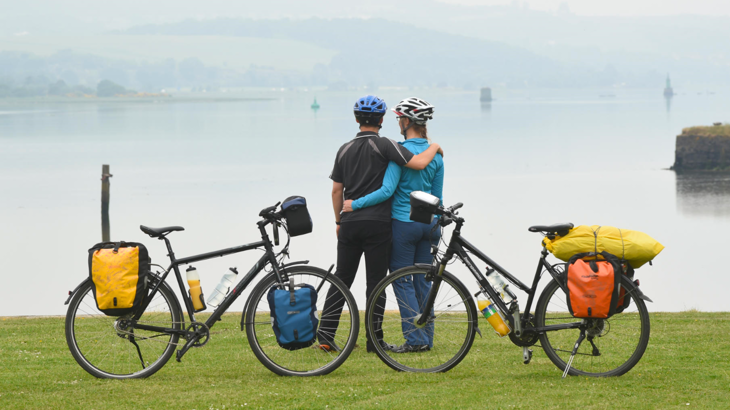
Cycling through the landscape is a great way to experience new places. Credit: Sustrans
How will you move your luggage?
Will you be carrying your luggage with you on your bike or transferring it each day?
If you’re carrying your own luggage, then you’ll need a good set of panniers or bike bags.
It might sound obvious but riding with a laden bike is a very different experience and if you’ve not done it before then it’s a good idea to do a practice ride to test how it impacts your cycling.
It’s not just the extra weight – riding with full panniers makes you a lot less aerodynamic too. A practice ride is also useful to help you streamline your kit list.
If you’re riding a popular established route, then there might be a luggage transfer service available.
Each one of the tours we operate at Skedaddle comes with luggage transfers because we think it makes the whole experience a lot more enjoyable.
When to go
It might be that you’ve only got a fixed window for your holiday.
If you have flexibility then consider the weather (too hot or too cold?), daylight hours, bank holidays and local events and festivals that could make your destination busy.
If you’re heading somewhere in peak season, you’ll need to book your accommodation well in advance.
You should also keep in mind if your route will be shared with other trail users. For example, if riding the Camino de Santiago in northern Spain you’ll share the trail with lots of walkers so you might want to avoid the peak season in August when it becomes busy.
It’s worth spending time doing your research before you go.
Have fun planning
Whether you’re finding your perfect Skedaddle holiday, or piecing together your own personal adventure, we think there is nothing more exciting than planning your next cycling holiday.





